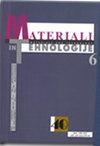STUDYING THE STRENGTH OF DISSIMILAR JOINTS OF AISI 430 AND 301 STAINLESS STEEL WELDED AT DIFFERENT WELDING PARAMETERS
IF 0.6
4区 材料科学
Q4 MATERIALS SCIENCE, MULTIDISCIPLINARY
引用次数: 0
Abstract
Investigating the best welding parameters for resistance spot welding joints between AISI 430 and AISI 301 stainless steels was the primary focus of this study. This research involved welding samples of these stainless steel types using various welding parameters. Ferritic stainless steel (AISI 430) and austenitic stainless steel (AISI 301) were subjected to resistance spot welding, and different welding conditions were applied to produce a range of samples. The study specifically analyzed the influence of the welding current (2.5, 3.1 and 3.7) kA and welding time (40, 70 and 100) ms on the joining capability of these stainless steels. To determine the best welding parameters, microhardness measurements and tensile-shear tests were performed on the welded materials. The results indicated that increasing the welding current and welding time led to an increase in the tensile load. The maximum tensile-shear load 2036 N was observed at 3.7 kA and 100 ms. However, after a salt spray test (48 and 96) h, a serious decrease in the tensile load from 2036 N to 750 was observed at the high current 3.7 kA and time (70 and 100) ms. At 3.1 kA and 70 ms before and after the salt test, its value remained relatively constant, and the corrosion resistance of the weld joint was at the best level. The microhardness of the heat-affected zone increased, reaching its maximum point (for 3.1 kA and 70 ms: 347.3 HV and for 3.1 kA 100 ms: 369 HV) in the fusion zone. Moreover, the increase in the welding time and current was associated with an increase in the nugget size. The maximum nugget size was 3.61 mm at 3.7 kA and 100 ms.研究不同焊接参数下 Aisi 430 和 301 不锈钢异种焊接接头的强度
本研究的主要重点是调查 AISI 430 和 AISI 301 不锈钢电阻点焊接头的最佳焊接参数。这项研究涉及使用各种焊接参数焊接这些不锈钢类型的样品。对铁素体不锈钢(AISI 430)和奥氏体不锈钢(AISI 301)进行了电阻点焊,并采用不同的焊接条件制作了一系列样品。研究具体分析了焊接电流(2.5、3.1 和 3.7)千安和焊接时间(40、70 和 100)毫秒对这些不锈钢连接能力的影响。为了确定最佳焊接参数,对焊接材料进行了显微硬度测量和拉伸剪切试验。结果表明,增加焊接电流和焊接时间可提高拉伸载荷。在 3.7 kA 和 100 ms 条件下,最大拉伸剪切载荷为 2036 N。然而,经过 48 和 96 小时的盐雾试验后,在 3.7 千安的高电流和 70 和 100 毫秒的时间条件下,拉伸载荷从 2036 牛减少到 750 牛。在盐试验前后的 3.1 kA 和 70 ms 条件下,其值保持相对稳定,焊点的耐腐蚀性能达到最佳水平。热影响区的显微硬度增加,在熔合区达到最大值(3.1 kA 和 70 ms 时:347.3 HV,3.1 kA 100 ms 时:369 HV)。此外,焊接时间和电流的增加与焊块尺寸的增大有关。在 3.7 kA 和 100 ms 条件下,最大金块尺寸为 3.61 mm。
本文章由计算机程序翻译,如有差异,请以英文原文为准。
求助全文
约1分钟内获得全文
求助全文
来源期刊

Materiali in tehnologije
工程技术-材料科学:综合
CiteScore
1.30
自引率
0.00%
发文量
73
审稿时长
4-8 weeks
期刊介绍:
The journal MATERIALI IN TEHNOLOGIJE/MATERIALS AND TECHNOLOGY is a scientific journal, devoted to original papers and review scientific papers concerned with the areas of fundamental and applied science and technology. Topics of particular interest include metallic materials, inorganic materials, polymers, vacuum technique and lately nanomaterials.
 求助内容:
求助内容: 应助结果提醒方式:
应助结果提醒方式:


